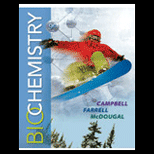
Concept explainers
MATHEMATICAL You do an enzyme kinetic experiment and calculate a
Interpretation:
The turnover number of the enzyme of the following enzyme-kinetic experiment is to be calculated.
Concept introduction:
In an enzymatic reaction, initially the substrate binds with the active site of an enzyme forming an enzyme–substrate [ES] intermediate that ultimately leads to the desired product.
The rate of production of product from the enzyme–substrate complex is known as,
Answer to Problem 31RE
Explanation of Solution
Given information:
Volume of an enzyme solution
Molecular weight of an enzyme
Concentration of enzyme solution
Turnover number of an enzyme represents the number of substrate moles, getting converted into product per enzyme molecule or per active site per unit time. The unit of the turnover number is sec-1 or min-1. The value of both
The turnover number
0.2 mg/ml is the density of an enzyme present in 0.1 ml of solution. Since,
Substitute 0.2 mg/mL for density and 0.1 mL for volume in the above expression for calculating the mass:
Now, for calculating the Enzyme concentration (density) in 1 ml of solution,
Substitute 0.02 mg for mass and 1 mL for volume,
Conversion of 0.02 mg into g is as follows:
128x 103 g of enzyme present in 1 mole of solution.
This implies, 1 g of enzyme present in
Thus, the concentration of
The value of total concentration
Since,
Recall the expression for the turnover number of an enzyme:
Substitute 1.56 x 10-10 mol for
Hence the calculation is as follows:
The turnover number of an enzyme is, the number of substrate molecules getting converted into product molecules by a single active site per unit time. The total concentration of enzymes is
Want to see more full solutions like this?
Chapter 6 Solutions
Bundle: Biochemistry, Loose-leaf Version, 9th + Owlv2,1 Term Printed Access Card
- The following data were recorded for the enzyme catalyzed conversion of S -> P. Question: Estimate the Vmax and Km. What would be the rate at 2.5 and 5.0 x 10-5 M [S] ?arrow_forwardPlease helparrow_forwardThe following data were recorded for the enzyme catalyzed conversion of S -> P Question: what would the rate be at 5.0 x 10-5 M [S] and the enzyme concentration was doubled? Also, the rate given in the table is from product accumulation after 10 minuets of reaction time. Verify these rates represent a true initial rate (less than 5% turnover). Please helparrow_forward
- The following data was obtained on isocitrate lyase from an algal species. Identify the reaction catalyzed by this enzyme, deduce the KM and Vmax , and determine the nature of the inhibition by oxaloacetate. Please helparrow_forwardIn the table below, there are sketches of four crystals made of positively-charged cations and negatively-charged anions. Rank these crystals in decreasing order of stability (or equivalently increasing order of energy). That is, select "1" below the most stable (lowest energy) crystal. Select "2" below the next most stable (next lowest energy) crystal, and so forth. A B 鹽 (Choose one) +2 C +2 +2 (Choose one) D 鹽雞 (Choose one) (Choose one)arrow_forward1. Draw the structures for the fats A. 16:2: w-3 and B. 18:3:49,12,15 2. Name each of the molecules below (image attached)arrow_forward
- draw the structures for the fats A. 16:2:w-3 B 18:3:9,12,15arrow_forward1. Below is a template strand of DNA. Show the mRNA and protein that would result. label the ends of the molecules ( refer to attached image)arrow_forwardAttach the followina labels to the diagram below: helicase, single stranded binding proteins, lagging strand, leading strand, DNA polymerase, primase, 5' ends (3), 3' ends (3) (image attached)arrow_forward
- 1. How much energy in terms of ATP can be obtained from tristearin (stearate is 18:0) Show steps pleasearrow_forwardMultiple choice urgent!!arrow_forward1. Write the transamination reaction for alanine. Indicate what happens next to each of the molecules in the reaction, and under what conditions it happens. 2.arrow_forward
 BiochemistryBiochemistryISBN:9781305961135Author:Mary K. Campbell, Shawn O. Farrell, Owen M. McDougalPublisher:Cengage Learning
BiochemistryBiochemistryISBN:9781305961135Author:Mary K. Campbell, Shawn O. Farrell, Owen M. McDougalPublisher:Cengage Learning
